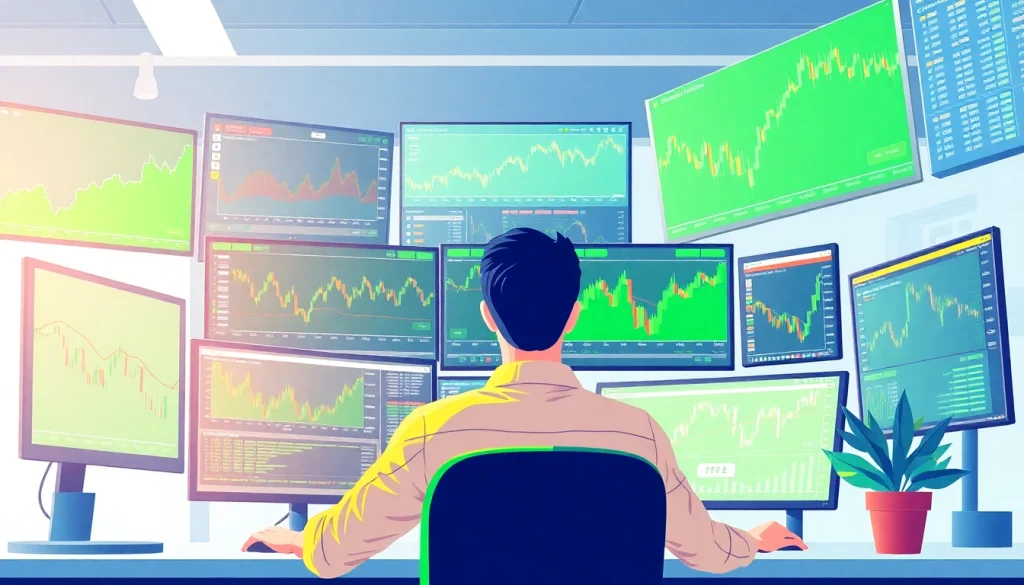
1. Understanding CFD Trading Basics
What is CFD Trading?
Contract for Difference (CFD) trading is a popular financial derivative that allows traders to speculate on the price movements of various assets without owning the underlying asset itself. Through this financial instrument, traders can gain exposure to a multitude of markets, including stocks, commodities, currencies, and indices. The essence of CFD trading is to capitalize on price fluctuations, enabling both potential profits and losses based on market performance.
In its simplest form, a CFD agreement is made between two parties: the buyer and the seller. The buyer pays the seller the difference between the current value of the asset and its value at the time the contract was opened. If the contract qualifies for a margin, it allows traders to enter large positions with relatively small capital, which can magnify profits but also increase risk significantly. To dive deeper into the intricacies of cfd trading, it’s essential to understand the fundamentals before venturing into any strategies or techniques.
The Mechanics of CFDs
The mechanics of CFD trading are relatively straightforward: you enter into a contract with a broker to buy or sell a financial instrument, such as a stock or commodity, based on its current market price. When trading CFDs, you don’t actually own the underlying asset but rather speculate on its future price movement. Here’s how it works:
- Opening a Position: Traders either buy (go long) if they believe the price will increase or sell (go short) if they think it will decrease.
- Margin and Leverage: CFDs are typically traded on margin, meaning that you only need to deposit a percentage of the total trade value to open a position. This can lead to leveraged gains, but also amplified losses.
- Closing a Position: The position is closed when the trader sells their CFD (if long) or repurchases (if short). The difference between the opening and closing price determines the profit or loss.
Advantages of CFD Trading
CFD trading offers numerous benefits, making it an attractive option for both novice and experienced traders:
- Flexibility: CFDs allow trading across various asset classes, including stocks, forex, commodities, and crypto.
- Leverage: Traders can control large positions with relatively small capital, increasing potential returns.
- Short Selling: Unlike traditional investing, CFDs allow traders to profit from declining markets by short selling.
- No Ownership: Since you’re not buying the actual asset, there are no costs associated with ownership, like management or maintenance fees.
- Access to Global Markets: Traders can access markets worldwide, often 24 hours a day, allowing for greater trading opportunities.
2. Navigating the CFD Markets
Types of Assets for CFD Trading
The CFD market is vast, encompassing numerous asset types that traders can utilize. Each asset class has its dynamics and may appeal to different trading strategies:
- Stocks: CFD trading allows traders to buy or sell shares of major companies without having to purchase the physical shares.
- Indices: CFDs can be traded on major stock indices, providing exposure to the overall performance of the market.
- Commodities: Traders can speculate on the price movements of physical commodities like gold, oil, and agricultural products.
- Forex: CFD trading in the forex market allows speculation on currency movements, leveraging price volatility.
- Cryptocurrencies: Many brokers now offer CFD trading on cryptocurrencies, appealing to investors seeking exposure to this burgeoning asset class.
Market Indicators & Trends
Effective CFD trading hinges on understanding market indicators and trends. Here are some essential tools and concepts:
- Technical Indicators: Using tools like moving averages, Relative Strength Index (RSI), and Bollinger Bands can help traders predict future price movements based on historical data.
- Fundamental Analysis: Assessing economic indicators such as GDP growth, employment rates, and interest rates can provide insights into market direction.
- Market Sentiment: Understanding the market’s overall mood, often gauged through sentiment indicators, can help predict price movements based on trader behavior.
- News Events: Keeping track of news releases and events can impact asset prices significantly, making it crucial for traders to stay informed.
Choosing a CFD Broker
Choosing the right CFD broker is vital for successful trading. Here are key factors to consider:
- Regulation: Ensure that the broker is regulated by a reputable authority to protect your funds and ensure fair trading practices.
- Trading Platform: A user-friendly and reliable trading platform is crucial. Check for features like charting tools, research resources, and mobile accessibility.
- Spreads and Fees: Compare spreads and commissions, as these can impact your profitability. Look for brokers that offer competitive pricing.
- Customer Support: A good customer service team can be invaluable. Ensure that support is available in your language and during convenient hours.
3. Strategies for Successful CFD Trading
Technical Analysis in CFD Trading
Technical analysis involves analyzing price charts and using statistical measures to make trading decisions. Here are some common techniques:
- Chart Patterns: Recognizing patterns like head and shoulders, flags, and triangles can provide significant insights into future price movements.
- Indicators: Utilizing indicators like MACD (Moving Average Convergence Divergence) and Fibonacci retracement can help identify potential reversals and entry points.
- Volume Analysis: Analyzing trading volume can provide context to price movements and signal potential reversals.
Risk Management Techniques
Effective risk management practices are essential in CFD trading to protect your capital. Here are best practices:
- Set Stop-Loss Orders: Always set stop-loss orders to limit potential losses on a trade.
- Position Sizing: Determine the appropriate position size based on your risk tolerance and account size.
- Diversification: Avoid putting all your capital into one asset; diversify across different markets and instruments to spread risk.
Developing a Trading Plan
A well-structured trading plan is crucial for guiding trading decisions. Key components include:
- Goals: Define clear, achievable trading goals, whether they be short-term or long-term.
- Strategy: Outline the trading strategies you plan to use, including indicators, timeframes, and asset classes.
- Review Process: Regularly review and adjust your trading plan based on performance and changing market conditions.
4. Advanced Topics in CFD Trading
Leveraging CFDs for Maximum Returns
Leverage can amplify both profits and losses in CFD trading. Traders must understand how it works:
When using leverage, you can control a larger position with a smaller amount of capital. For example, a 100:1 leverage allows a trader to control $10,000 worth of assets by only putting up $100. While this can magnify returns, it also increases risk significantly. Here are best practices:
- Use Moderate Leverage: Stick to lower leverage ratios, especially as a beginner, to mitigate risk.
- Maintain Sufficient Margin: Always monitor your margin level to avoid margin calls, which occur when your account balance falls below the required level.
Understanding Margin and Leverage
Margin and leverage are critical concepts in CFD trading. Here’s a breakdown:
- Margin: The amount of money required to open a position, typically expressed as a percentage of the total trade value.
- Leverage: The capability to control a larger position size with a smaller amount of capital. While leverage can enhance profits, it also significantly increases risk.
Common Pitfalls to Avoid in CFD Trading
While CFD trading offers substantial opportunities, several common pitfalls can undermine success:
- Overleveraging: Using high leverage can lead to substantial losses. It’s essential to trade within your means and utilize leverage wisely.
- Lack of a Trading Plan: Trading without a plan can result in emotional decision-making and erratic results.
- Ignoring Risk Management: Not employing adequate risk management strategies can jeopardize your trading account.
5. Future Trends in CFD Trading
The Role of Technology in CFD Trading
Technology plays a crucial role in the evolution of CFD trading. Key trends include:
- Algorithmic Trading: The use of algorithms and automated trading systems to execute trades based on predetermined criteria is becoming increasingly prevalent.
- Mobile Trading Platforms: With the rise of mobile trading apps, traders can now manage their accounts and execute trades on the go.
- AI and Machine Learning: As these technologies advance, they are beginning to inform trading strategies and risk management techniques, allowing for more data-driven decision-making.
Regulatory Considerations for CFD Traders
The regulatory landscape for CFD trading continues to evolve. Key considerations include:
- Regulatory Bodies: Understanding which regulatory bodies govern CFD brokers in your region can impact your trading strategy.
- Compliance Requirements: Adhering to local laws and regulations regarding trading can help protect you from legal consequences.
- Changes in Regulations: Remaining informed about changes in CFD regulations is crucial as these can impact trading conditions, including margin requirements and leverage limits.
CFD Trading in Emerging Markets
Emerging markets offer unique opportunities for CFD traders. Here’s what to consider:
- Growth Potential: Many emerging markets are characterized by high growth rates, which can lead to considerable price volatility.
- Increased Risk: Political instability and economic uncertainty in emerging markets can amplify risks for CFD traders.
- Diverse Opportunities: Identifying and understanding local market dynamics can uncover trading opportunities that may not be available in more developed markets.



